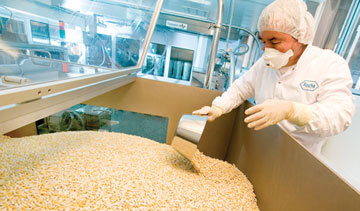PHARMACEUTICALS
Fast Spread of Capacity
 |
 William M. Burns, CEO of the Roche Pharma division, has sought both manufacturing and research partners worldwide in order to bump up Tamiflu production capacity to 400 million treatments as well as bump up the pace of research on the H5N1 virus. William M. Burns, CEO of the Roche Pharma division, has sought both manufacturing and research partners worldwide in order to bump up Tamiflu production capacity to 400 million treatments as well as bump up the pace of research on the H5N1 virus.
Photo courtesy of Roche |
The warnings about a pending avian flu pandemic related to the H5N1 virus have now been sounding from all quarters for many months. While there is no vaccine, one identified treatment for influenza is Tamiflu, invented by Gilead Sciences and licensed to Basel, Switzerland-based Roche in 1996. Roche and Gilead partnered on clinical development, with Roche leading efforts to produce, register and bring the product to the markets. Under the terms of the companies' agreement, amended in November 2005, Gilead participates with Roche in the consideration of sub-licenses for the pandemic supply of oseltamivir, the key ingredient in Tamiflu that is derived in part from the star anise plant.
Pursuant to that agreement and others, Roche announced in March 2006 that, in concert with new research on Tamiflu and the H5N1 virus, it was expanding Tamiflu production to reach a capacity of 400 million annual treatments, a 33-percent expansion.
"Roche's global network for the manufacture of Tamiflu will include several Roche sites and more than 15 external contractors located in nine different countries around the world," read a company release. "These production partners have been selected primarily on the basis of their ability to produce substantial quantities of intermediates and finished materials in accordance with Roche's quality standards in a relatively short time frame."
Roche spokesman Terry Hurley says no further detail about specific facilities where Tamiflu production is increasing is being released. However, the companies involved include Albemarle, Ampac Fine Chemicals LLC, API Corporation, Clariant, DSM, FIS, Martek Biosciences Corporation, Novasep/Dynamit Nobel, PHT International, PPG Industries, Sanofi-Aventis, Shaanxi Jiahe Phytochem Co and Siegfried Ltd. Given that star anise is available primarily in China, it comes as no surprise that Roche also is in final-stage negotiations for a sublicense with a Chinese company, and the firm granted sublicenses in 2005 to Hetero and Shanghai Pharmaceuticals.
"Of course, the rate at which this capacity is utilized will depend in large part on the future order flow from governments around the world," said William M. Burns, CEO of the Roche Pharma division. "We are now ahead of demand in meeting the manufacturing challenge, but as a research based company, our role goes beyond this. We are committed to further expanding the knowledge base regarding Tamiflu and the H5N1 virus, but we cannot do this alone and we need to collaborate with third parties moving forward."
Already, Roche has received and fulfilled pandemic orders for Tamiflu from more than 65 countries, with France, Finland, Iceland, Ireland, Luxembourg, Netherlands, New Zealand, Norway, Switzerland and the U.K. stockpiling or intending to stockpile adequate Tamiflu to cover between 20 percent and 40 percent of their populations.
Unnamed locations are not the only ones in the Roche family that are expanding. Roche has a majority interest in Genentech, in the midst of a $600-million expansion in Vacaville, Calif. And Roche's diagnostics complex in Penzberg, Germany, is in the midst of a $53-million expansion.
